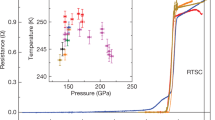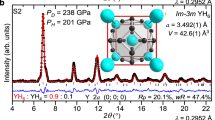Abstract
The initial discovery by Bednorz and Muller1 of 35-K superconduc-tivity in the La–Ba–Cu–O system has stimulated worldwide activity in searching for higher-temperature superconductors. Elemental substitution has proved to be most effective in raising transition temperature. Substitution of Sr for Ba has produced 40-K super-conductivity2–5, and substitution of Y for La has produced a new high-temperature superconductor with transition temperature above liquid-nitrogen temperature6. A class of superconducting compounds of the form RBa2Cu3O7−x has been explored by further substitutions of other rare earths (Y is considered in the rare-earth [R] category here) for Y7–13. To date, a rare earth, an alkaline earth, copper and oxygen have been required for all high-temperature superconductors14,15. (Zhang et al.14 reported 90-K superconductivity in the Th–Ba–Pb(Zr) –Cu–O system. Pan et al.15 reported 50-K superconductivity in the Y–Ba–Ag–O system. As Th is a member of the actinide series which belongs to the same Group 3B in the periodic table as the lanthanide series and Ag belongs to the same Group IB as Cu, high-temperature supercon-ductors are still thought to be closed in the Group 3B–Group 2A–Group 1B–oxygen system.) Only partial substitutions have led to superconductors, but with no significant rise of transition tem-perature (the only exception is 40-K superconductivity in La2CuO4−x, refs 16, 17). Here we report superconductivity in the rare-earth-free Tl–Ba–Cu–O system. We have observed sharp drops of resistance starting above 90 K with zero resistance at 81 K in this system. Magnetic measurements have confirmed that these sharp drops of resistance in the Tl–Ba–Cu-–O samples origi-nate from superconductivity. The samples are stable in air for at least two months, and their preparation is easily reproduced.
This is a preview of subscription content, access via your institution
Access options
Subscribe to this journal
Receive 51 print issues and online access
$199.00 per year
only $3.90 per issue
Buy this article
- Purchase on Springer Link
- Instant access to full article PDF
Prices may be subject to local taxes which are calculated during checkout
Similar content being viewed by others
References
Bednorz, J. G. & Muller, K. A. Z. Phys B64, 189–193 (1986).
Chu, C. W. et al. Phys. Rev. Lett. 58, 405–407 (1987).
Chu, C. W. et al. Science 235, 567–569 (1987).
Cava, J. et al. Phys. Rev. Lett. 58, 408–410 (1987).
Tarascon, J. M. et al. Science 235, 1373–1376 (1987).
Wu, M. K. et al. Phys. Rev. Lett. 58, 908–910 (1987).
Murphy, D. et al. Phys. Rev. Lett. 58, 1888–1890 (1987).
Hor, P. H. et al. Phys. Rev. Lett. 58, 1891–1894 (1987).
Moodenbaugh, M. et al. Phys. Rev. Lett. 58, 1885–1887 (1987).
Hosoya, S. et al. Jap. J. appl. Phys. 26, L325–L326 (1987).
Kitazawa, K. et al. Jap. J. appl. Phys. 26, L339–L341 (1987).
Hikami, S. et al. Jap. J. appl. Phys. 26, L347–L348 (1987).
Hosoya, S. et al. Jap. J. appl. Phys. 26, L456–L457 (1987).
Zhang, Y. L. et al. preprint (1987).
Pan, K. K. et al. Phys. Lett. A125, 147–148 (1987).
Grant, P. M. et al. Phys. Rev. Lett. 58, 2482–2485 (1987).
Michel, C. et al. Z. Phys. B68, 421–423 (1987).
Cava, J. et al. Phys. Rev. Lett. 58, 1676–1679 (1987).
Weast, R. C. W. & Astle, M. J. (eds) in Handbook of Physics and Chemistry, 62nd edn, B-156, F-175 (CRC, Boca Raton, 1981).
Bailar, J. C. Jr et al. Comprehensive Inorganic Chemistry (Pergamon, Oxford, 1973).
Hermann, A. M. & Sheng, Z. Z. Appl. Phys. Lett. 51, 1854–1856 (1987).
Hermann, R. et al. Appl. Phys. Commun. 7, 275–283 (1987).
White, G. K. & Woods, S. B. Phil. Trans. R. Soc. A251, 272 (1959).
Ovshinsky, S. R. et al. Phys. Rev. Lett. 58, 2579–2581 (1987).
Kagoshima, S. et al. Jap. J. appl. Phys. 26, L318–L319 (1987).
Matsushita, A. et al. Jap. J. appl. Phys. 26, L332–L333 (1987).
Norton, M. L. J. Phys. E. Sci. Instrum, 19, 268–270 (1986).
Author information
Authors and Affiliations
Rights and permissions
About this article
Cite this article
Sheng, Z., Hermann, A. Superconductivity in the rare-earth-free Tl–Ba–Cu–O system above liquid-nitrogen temperature. Nature 332, 55–58 (1988). https://doi.org/10.1038/332055a0
Received:
Accepted:
Issue Date:
DOI: https://doi.org/10.1038/332055a0
This article is cited by
-
Comparative Study of Structural, Electrical, and Mechanical Properties of (Tl, Hg)-1223 High Temperature Superconducting Phase Substituted by Lead Oxide and Lead Dioxide
Journal of Low Temperature Physics (2023)
-
Effects of cobalt nanoparticles addition in Cu0.5Tl0.5-1223 superconductor composite
Journal of Electroceramics (2023)
-
The Effect of Zinc on the Structural, Electrical, and Mechanical Properties of YBCO-123 Superconducting Nanoparticles Prepared by an Acetate-Based Sol-Gel Process
Journal of Superconductivity and Novel Magnetism (2019)
-
Effects of Forming Pressure on Physicochemical Properties of YBCO Ceramics
Journal of Superconductivity and Novel Magnetism (2018)
-
Physical Properties of \((\hbox {BaSnO}_{3})_\mathrm{x}/\hbox {Cu}_{0.5}\hbox {Tl}_{0.5}\hbox {Ba}_{2}\hbox {Ca}_{2}\hbox {Cu}_{3}\hbox {O}_{10{-}\delta }\) ( BaSnO 3 ) x / Cu 0.5 Tl 0.5 Ba 2 Ca 2 Cu 3 O 10 - δ Superconductor Composite
Journal of Low Temperature Physics (2017)
Comments
By submitting a comment you agree to abide by our Terms and Community Guidelines. If you find something abusive or that does not comply with our terms or guidelines please flag it as inappropriate.



